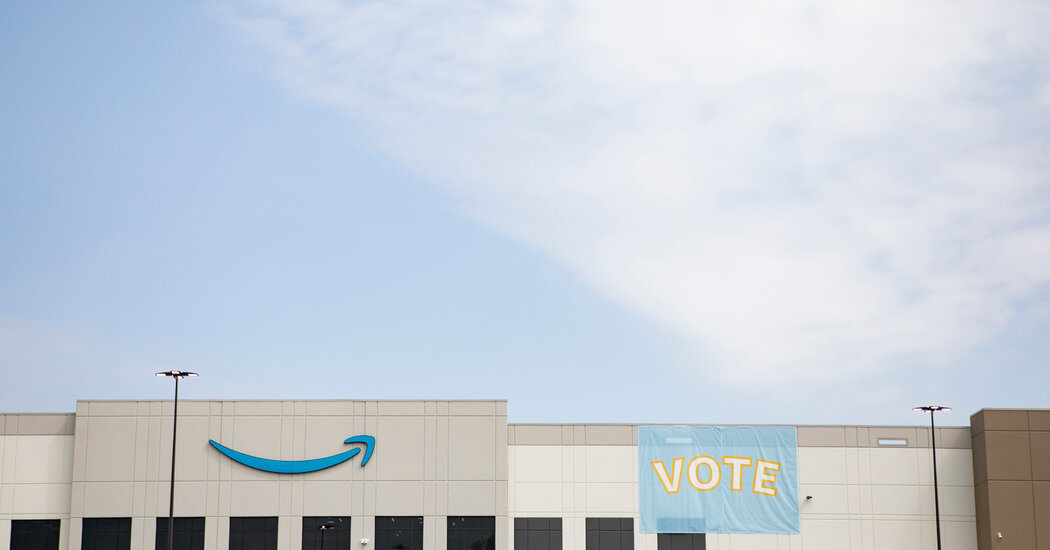A regional office of the National Labor Relations Board on Monday ordered a new union election at an Amazon warehouse in Alabama, upholding a union challenge to a vote that the company won decisively.
The decision was widely expected after a hearing officer recommended in August that the results be thrown out and that a new election take place.
The company declared after the August decision that it intended to appeal to the labor board in Washington if it did not prevail at the regional level, but it did not say Monday whether it would follow through.
Roughly half of the nearly 6,000 eligible workers at the warehouse in Bessemer, Ala., cast ballots by mail in February and March on whether to join the Retail, Wholesale and Department Store Union. The tally against the unionization bid was two to one.
The union filed a formal objection to the election shortly after the results were announced in April, arguing that Amazon had undermined the conditions for a fair election by pressing the Postal Service to install a collection box at the warehouse, among other complaints. The union said the box, which was not authorized by the labor board, created the impression that Amazon was monitoring which workers voted.
In her decision Monday, the labor board’s regional director for the Atlanta region agreed, writing that Amazon “gave a strong impression that it controlled the process” by arranging the installation of the box. “This dangerous and improper message to employees destroys trust in the board’s processes and in the credibility of the election results,” the director, Lisa Y. Henderson, concluded.
Ms. Henderson also found that Amazon had improperly “polled” employees — that is, it attempted to determine how they would vote — by notifying workers at mandatory meetings that they could take “vote no” items such as pins that were laid out in full view of human resources officials.
Stuart Appelbaum, the union’s president, said in a statement on Monday that the decision showed that “Amazon’s intimidation and interference prevented workers from having a fair say in whether they wanted a union.”
Amazon has said that the box was intended to make it easier for employees to vote and that it did not have access to the ballots that workers deposited in it.
“Our employees have always had the choice of whether or not to join a union, and they overwhelmingly chose not to join the R.W.D.S.U. earlier this year,” Kelly Nantel, an Amazon spokeswoman, said in a statement. “It’s disappointing that the N.L.R.B. has now decided that those votes shouldn’t count. As a company, we don’t think unions are the best answer for our employees.”
The regional office’s decision is a setback to Amazon at a time when its labor model is under increasing scrutiny. In September, California approved a law that would require warehouse employers like Amazon to disclose the productivity quotas that they impose on workers and would prohibit quotas that prevent workers from taking breaks and abiding by health and safety rules.
Earlier this month, the nearly 1.4 million-member International Brotherhood of Teamsters elected a new president who ran partly on a promise of an aggressive campaign to unionize the company.
The Bessemer campaign was arguably the most serious challenge ever from a union at a domestic facility owned by Amazon, which currently has no unionized warehouses in the United States. Amazon warehouse workers on Staten Island appeared to qualify for a union election in October, but later withdrew their request for a vote.
Understand Amazon’s Employment System
In objecting to the way the Bessemer election was conducted, the retail workers’ union argued that Amazon consultants and managers created fear among workers by removing them from mandatory anti-union meetings if they asked skeptical questions and by telling workers they risked loss of pay or benefits, or even their jobs, if they unionized.
The August recommendation by the labor board’s hearing officer dismissed many of the union’s objections in this vein, but the officer found that “the employer’s unilateral decision to create, for all intents and purposes, an on-site collection box for N.L.R.B. ballots destroyed the laboratory conditions” that are supposed to prevail during a union election.
The hearing officer highlighted the fact that the collection box was surrounded by a tent, on which Amazon printed a campaign message (“speak for yourself”) and a directive to workers to “mail your ballot here,” and that the tent appeared to be in view of Amazon’s surveillance cameras.
Ms. Henderson, the regional director, echoed those conclusions and said Amazon had essentially flouted her pre-election ruling denying the company’s request to provide equipment, like certain types of boxes, to help ensure the safe collection of ballots during a manual election.
“I specifically disapproved of the employer’s suggestions for making voting ‘easier’ because the employer is neither responsible for conducting elections nor is it tasked or authorized to aid the process,” Ms. Henderson wrote.
She added: “The employer ignored the spirit of my directive by unilaterally requisitioning the installation of a postal mailbox.”
